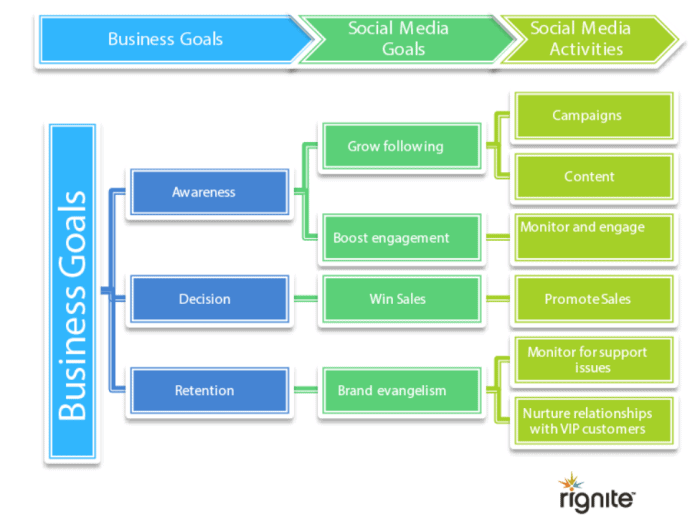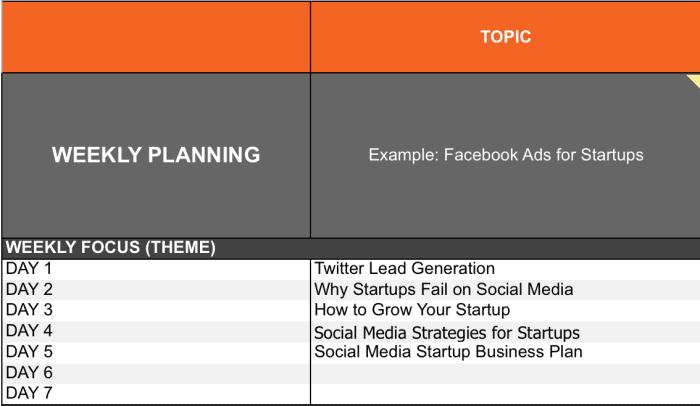Do you scramble to find content to post on social media? Rush to share something because you feel the pressure to post?
If you struggle to organize, plan, and post content to social media... there's a better way! In this episode of the Brand Authority Podcast, I share the first of a three-part system on how to create your customized social media calendar.
Listen in and learn how you can get your content into a manageable and holistic marketing strategy.
Subscribe to Brand Authority Podcast on iTunes
Highlights from episode 23
1. Set social media goals
Goals give you direction and act as your roadmap. If you haven't considered what your goals might be, begin at the top with your overall business goals. Now let your social media objectives and key results roll up into those goals.
Think about it... if your company or team has a difficult time aligning sales and marketing, there's a reason. The same holds true for your company and all other goals.
Ensure that the social media goals you create are in direct alignment with everything your company is trying to achieve. You want every aspect of your organization working together towards the overarching goals.
For example, if your business goal is to increase sales, your social media goal may be to create 5 pieces of content each week that raise awareness around a specific feature within your product.

Source: CV For Teaching
2. Content Brainstorming
Your next step is to brainstorm content. Focus on content that:
- Your audience wants (seems simple, but it takes a deep understanding of their NEEDS)
- You've already created, has been wildly successful, and you can repurpose into new media
Start by determining what topics matter most to your audience. Here's how:
- Google Analytics
Take a look at your blog post performance. Review the top 25 and sort them based on posts:
- Creating subscribers
- Driving the most leads
- Turning leads into contacts and sales
Now, think about how you can take one of those blog posts and turn it into additional pieces of content. This could be anything from a tweet to an Infographic or a video.
Each type of media will go into your editorial calendar and continue to drive traffic to the original piece of content.
- Your Competition
Learn from the success of your competition. No, you're not looking to emulate or copy what they've done, only model their success.For example, let's say they've written a post around a topic your audience is interested in. Consider how to put your own unique spin on the topic and solution.
Buzzsumo is a great tool to use to keep an eye on your competition. Within it, you'll get a quick snapshot of any keyword, topic, or website. Simply go to the content research tab and type in the domain of your competitors. Look at the social engagement on each post. If there's a topic you're knowledgeable in, write around a similar topic.

3. Determine the right type of content
It's not enough to randomly share content and hope it produces results. You need to share the type of content that converts lookie-loos into customers. The content formats that convert include:
- Blog posts
- White papers
- Webinars
- Ebooks
- Case studies
- Workbooks
- Checklists
- Video guides
- Tutorials
Choose ONE, implement, and test. How does your audience respond? Now tweak, adjust, test again. If you focus on too many at once or more than one variable, you'll never be able to track the results.
4. Build out your social media calendar
It's finally time to take the research you performed and marry it into an actionable plan.
Step 1. Focus on content themes
Your themes are based on your keyword-based topics. Break these down into a daily focus and treat each theme like a content bucket. To get started, write out 5 questions you can answer around each topic or theme. Then add one question to a week in your calendar.
Here's an example of what that might look like:
Content Theme: Facebook Ads for Startups
Questions you can answer that become blog, social, and video posts:
- How to grow my startup with Facebook Ads?
- How to use Facebook Ads to increase sales?
- What's the best Facebook Ad strategy for startups?
- How do I create a Facebook ad budget for my startup?
- Why aren't Facebook Ads working for my startup?

You see that I've written those based on how my audience would actually search on Google for an answer. Do the same and match your solution to their exact need.
Step 2. Choose your destination(s)
You don't have to be everything to everybody. You also don't have to be on every social channel. Figure out where your audience is spending time and make a commitment to showing up there daily.
Step 3. Add a call to action
When you're creating content, don't forget the final piece... your call to action. Too often, I see people leave what happens next to chance. Think about what steps you want your audience to take, and don't mince words. Confused minds don't click, comment, share, or buy. Be clear!
5. Create your posting strategy
Once you're done with the planning and visualization, you need a posting schedule - a checklist of your daily, weekly, and monthly tasks. For that, there are a few things you need to get clear on:
- Which social media channels you'll use
- Which type of content you'll share on each one
- What your call to action will be
- How often to post on each channel
To determine how often to post, look at your analytics, and see when your audience is online.
6. Choose the right tools
There are a lot of tools that can help you stay active on social media. However, don't get too carried away and automate everything. Leave room to go in and engage!
For example, you can set aside 15 minutes at the beginning and end of the day to monitor your mentions with tools like Commun.It and Brand 24.

Consider using a social management tool like Agorapulse, Sprout Social, or Buffer. Add content into your calendar, manage via one of these tools, and you won't have to keep it all in your head. True Social Metrics is another great tool. It can help you better understand when and how your audience is spending their time online.
Final thoughts
Think of your social media content as a part of the bigger picture. It should support everything you're working towards within your business. Get strategic and pay attention to what your audience is telling you. When you truly take the time to listen and engage, you turn your audience into contacts, leads, and sales in no time.
Subscribe to the Brand Authority Podcast
People, brands and resources mentioned:
Social Media Calendar Template
How to Fill Up Your Social Media Calendar
Want to View on YouTube Instead?
About Rebekah Radice
Rebekah Radice, co-founder of BRIL.LA, has traded narcissism for purpose. When not driving growth, you'll find her tricking family into thinking she's Emeril Lagasse - likely covered in marinara. The spotlight was fun, but impact is better. These days she's using 20+ years of brand brilliance for good.
